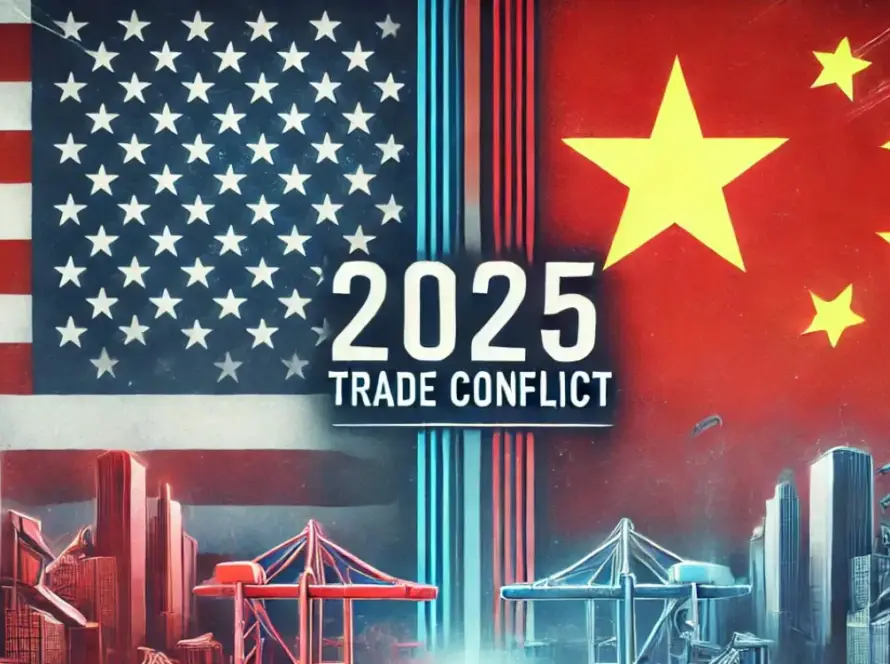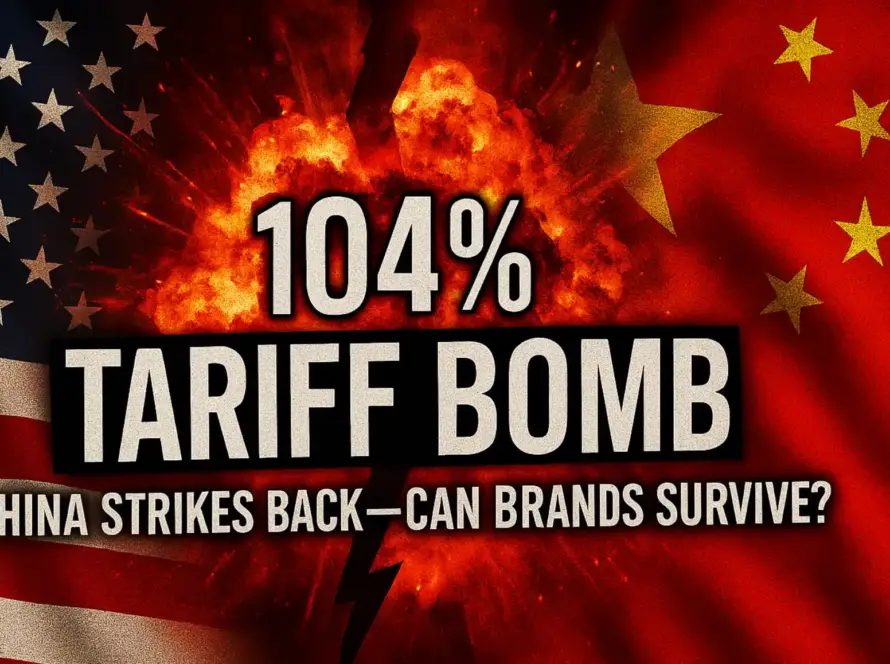I. April 2025: Globalization Faces a New Blow
On April 2, 2025, the Trump administration reignited global trade tensions. It announced a two-tier tariff scheme. The policy targets over 20 major economies. These include China, the European Union, Japan, and South Korea:
- A 10% base tariff on all imported goods;
- An additional 17% to 49% reciprocal surcharge on selected countries, raising the total tariff on Chinese goods to 34%.
Many analysts consider this the most significant one-sided tariff move since the 2018 U.S.-China trade war. The Office of the United States Trade Representative (USTR) explained the goal of this move. It aims to rebalance trade and punish unfair subsidies and market restrictions.
II. China in the Crosshairs: Strategic Calculations Behind the Tariff Surge
China was the primary target of this tariff campaign. The White House released official documents detailing the new tariff plan. The average tariff rate on Chinese exports to the U.S. rose from 20% to 34%. Affected goods include machinery, consumer electronics, medical devices, toys, apparel, and adult products.
Guo Jiakun, spokesperson for China’s Ministry of Foreign Affairs, made a firm statement. He said the U.S. tariff actions violate World Trade Organization (WTO) rules and damage the global trade system. These moves, he warned, could destabilize supply chains worldwide.Profound Impacts on China’s Economy
The upgraded tariffs have already imposed multiple layers of pressure on China’s real economy:
- Export orders are now under serious pressure. High tariffs make Chinese products less competitive in global markets. As a result, many exporters face order losses, supply chain delays, and job cuts. This impact is especially severe in the sex toy industry and other labor-intensive sectors.
- Many exporters are now reviewing their supply chains. To avoid tariff barriers, some plan to shift production to Southeast Asia or Latin America. This move could weaken both general manufacturing and sex toy manufacturing in China, disrupting long-term supply chain strategies.
- China’s economic momentum is slowing. Exports are one of its three main growth drivers. But they now face new constraints. This may reduce GDP growth, especially in export-heavy provinces like Guangdong, Zhejiang, and Jiangsu.
Sectors like smart electronics, green technology, and Chinese sex toy brands feel the pressure most. These industries rely on both innovation and global demand.
China’s Firm Response: Tariffs, Rare Earths, and Legal Action
The Chinese government quickly reacted with a combination of countermeasures:
- China responded with reciprocal tariffs. Starting at 12:01 p.m. on April 10, it imposed a 34% tax on all U.S.-origin goods. This move aims to protect and stabilize domestic industries.
- China also tightened its control on rare earth exports. New rules now limit shipments of key elements to the U.S., including samarium, gadolinium, terbium, dysprosium, and scandium. These materials are vital to America’s high-tech and defense sectors, according to the Wall Street Journal.
- China filed an official complaint at the World Trade Organization. It accused the U.S. of breaking trade rules under the General Agreement on Tariffs and Trade (GATT). China also called for a shared solution involving other countries through the WTO process.
The U.S.-China dispute has gone beyond economics. Experts say the real issue is global power competition. Keeping trade fair and stable is more important than ever.
III. A Chain Reaction: How the World Responded
While China was hit hardest, the impact of these tariffs quickly spread.
EU: Direct Blow and Coordinated Response
The new U.S. tariffs included a 20% surcharge on goods from the European Union. EU Commission President Ursula von der Leyen warned that the tariffs pose a serious threat to global order. She also said the EU will work with other affected nations to plan a joint response. Germany’s Federation of Industries (BDI) warned that hundreds of thousands of manufacturing jobs were at risk.
These tariffs may also impact toy manufacturers across Europe who rely on global materials and parts.
UK and Nordic States: Seeking Unified Action
UK Prime Minister Keir Starmer said the UK would work with allies to draft a united response. Swiss President Karin Keller-Sutter promised swift domestic measures. Norwegian Prime Minister Jonas Gahr Støre said the new tariffs are hurting local businesses and jobs. He added that talks with the U.S. will begin soon.
Japan and South Korea: Trade Impact and Political Response
Japan and South Korea were both subject to 24% and 25% tariffs. On the announcement day, the Nikkei and KOSPI indexes each dropped by over 2%. Japan’s Trade Minister Toshimitsu Motegi expressed “deep regret” and pledged to seek exemption through negotiation.
Canada and Mexico: Not Yet Hit, But Anxious
Though not affected in this round, concerns are growing that Canada and Mexico may be next. Canadian Prime Minister Mark Carney vowed to take steps to defend national workers and businesses.
Global Institutions: Warning Signs Ahead
The International Monetary Fund (IMF) issued a warning. It said global trade could shrink by 1.2% to 2.5%. GDP forecasts might also fall by at least 0.3 percentage points.
IV. Global Institutions and Economists Speak Out
The economic community has voiced strong criticism:
- IMF Director Kristalina Georgieva said: “This move places a steel rail across the path of economic recovery.”
- The WTO warned that the U.S. tariffs could accelerate the fragmentation of global trade.
- Nobel Laureate Paul Krugman wrote in The New York Times that it is “one of the most destructive trade policies of this century.”
Even U.S. voices oppose the move. The National Retail Federation (NRF) spoke out against the tariffs. It warned that prices in stores will rise. Consumers will have less buying power, and many small businesses may suffer.
V. Financial Markets React: Chain Reactions Across Assets
The new tariffs caused price swings across global markets:
- The dollar weakened; gold surged past $2,250; the yen strengthened.
- The Dow Jones dropped over 800 points in two days.
- Brent crude fell nearly 7%, hitting a three-year low.
- Global manufacturing PMIs continued to decline for the third consecutive month.
Investment firms like BlackRock and Morgan Stanley have warned of reduced confidence and a shift toward risk aversion. These changes may affect raw materials sourcing, electric motor production, and pricing across vibratory equipment sectors. Global steel demand has also dipped because companies are delaying their purchase of key inputs like iron ore.
VI. Impact on Chinese B2B Exporters: Strategy Amid Crisis
As tariff pressure mounts, Chinese B2B exporters are under strain. Gaia in Love, a women’s wellness brand rooted in technology, has responded with three main strategies:
Sharing pressure with clients:
- Cost-sharing models reduce the tariff burden while maintaining cost-effective pricing.
- Flexible pricing based on volume and loyalty helps clients stay competitive in a wide range of adult product categories.
Overseas manufacturing and split production:
- Partnering with clients to build overseas plants in tariff-friendly regions.
- Maintaining core production in China and assembling abroad preserves IP and lowers tariffs.
Entering New Regions:
- Expanding in Southeast Asia, the Middle East, and Latin America.
- Adapting product designs to local needs, offering custom solutions tailored to buying adult behavior and preferences.
These moves show a growing trend in China’s sex toy export sector. Today, vibrator manufacturers must move fast and work with precision to survive. In volatile times, flexibility is survival. Gaia in Love builds trust through cooperation and resilience through innovation.
Gaia in Love continues to improve its sex toy manufacture process. Each product follows local laws and meets global quality standards. In volatile times, flexibility is survival. Gaia in Love builds trust through cooperation and resilience through innovation.
VII. Rising Against the Wind: A Brand’s True Beginning
This is not the first global shock Chinese exporters have faced. In 2008, the global financial crisis slashed demand. But from that storm, Chinese manufacturing emerged stronger.
“We moved from OEM to industrial upgrading, from price competition to brand building.”
In 2025, Gaia in Love once again chooses to move forward against the wind. With a mature industry base, a global mindset, and brand confidence, it sees challenge as opportunity.
We empower women through technology and build future-ready supply chains with our partners. Our adult toy factory in China remains focused on quality, innovation, and compliance. We maintain a solid vibrator OEM strategy, and constantly invest in innovative designs that meet changing consumer demands.
Short-term pressure will not weaken the foundation of long-term partnerships. True brands will prove their strength in hard times. Global vibration is not just a product feature—it’s the rhythm of global business today.
We survived the last crisis and will walk out of this tariff storm too. The future belongs to those who plant seeds during the storm.
Explore More of Our Articles
- Why Gaia in Love Is Not Just Another Chinese Sex Toy Factory?
- Gaia in Love at Guangzhou Expo: Innovating for Women’s Wellness
- Does Importing Wholesale Sex Toys from China Save Money?
- Efficient Inventory Management for Women Toys
- Best Adult Sex Toys Manufacturer in China: Build Your Brand
- Ladies Sexy Aids: A Comprehensive Guide to U.S. Regulations by Gaia in Love
- STIMULATE: A Hub for Sexual Wellness & Women’s Health
- Actionable Feedback Policy




